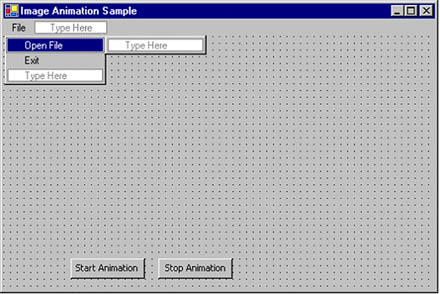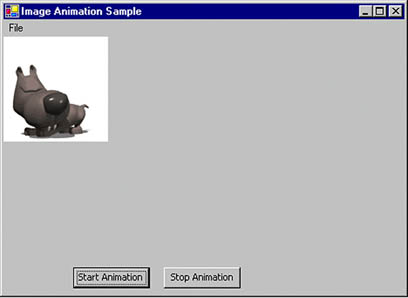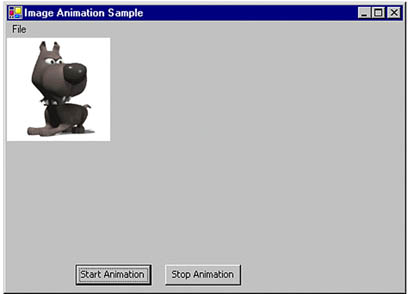Playing Animations in GDI+
So far we have been dealing with static image formats, such as BMP. Each of these formats holds image data for a single picture. Other formatssuch as GIF, AVI (Audio Video Interleaved), and MPEG (Moving Picture Experts Group)contain image data that, when played back in quick succession, gives the illusion of movement. These images are called animated images. GIF is one of the common formats used for animated images. An animated image is a series of images, also called frames (e.g., see Figure 7.29).
Figure 7.29. An animated image with three frames

You can create animated images by using graphics tools such as Macromedia Fireworks or CorelDRAW, but GDI+ doesn't support the creation of animated images. When you create animated images, you must specify the order of frames and the time interval between them.
The GDI+ library provides the ImageAnimator class to deal with animated file formats using time-based frames. At this time, GDI+ supports only multiframe GIFs and TIFFs. ImageAnimator has four static methods: Animate, CanAnimate, StopAnimate, and UpdateFrames.
- The Animate method displays a framed image as an animation. This method takes parameters of type Image and EventHandler. Image is the image you want to animate. The event is triggered when the currently displayed frame is changed.
- The CanAnimate method returns true when an image has timebased frames.
- The StopAnimate method terminates an animation. It takes parameters of type Image and EventHandler.
- The UpdateFrames method will move to the next frame and render it the next time the image is drawn.
Now let's write an application that will play animated images. We create a Windows application and add a MainMenu control and two button controls to the form. We also add two menu items: Open File and Exit. We change the text and names of the menu items and button controls as shown in Figure 7.30.
Figure 7.30. An image animation example

We add two variables of type Image and string as follows:
private Image curImage = null; private string curFileName = null;
The Open File menu item allows us to browse images, and the Exit menu item closes the form. Listing 7.13 gives the code for the click event handlers for these two menu items.
Listing 7.13 The Open File and Exit menu item click event handlers
private Image curImage;
private void OpenFileMenu_Click(object sender,
System.EventArgs e)
{
// Create OpenFileDialog
OpenFileDialog opnDlg = new OpenFileDialog();
opnDlg.Filter = "Animated Gifs|*.gif;";
// If OK, selected
if(opnDlg.ShowDialog() == DialogResult.OK)
{
// Read current selected file name
curFileName = opnDlg.FileName;
}
}
private void ExitMenu_Click(object sender,
System.EventArgs e)
{
this.Close();
}
Now we rename the two buttons Start Animation and Stop Animation, respectively, and write click event handlers by double-clicking on them. The code for the StartAnimationBtn event handler is given in Listing 7.14. We create an Image object by calling FromImage, which takes an image file as its only argument. Then we use the CanAnimate method to check if the image can be animated. If it can, we call Animate, which plays the animation.
Listing 7.14 The StartAnimationBtn click event handler
private void StartAnimationBtn_Click(object sender,
System.EventArgs e)
{
curImage = Image.FromFile(curFileName);
if( ImageAnimator.CanAnimate(curImage) )
{
ImageAnimator.Animate(curImage,
new EventHandler(this.OnFrameChanged));
}
else
MessageBox.Show("Image doesn't have frames");
}
On the StopAnimationBtn click event handler, we check whether there is an Image object, and we call StopAnimate to stop the animation as shown in Listing 7.15.
Listing 7.15 The StopAnimationBtn click event handler
private void StopAnimationBtn_Click(object sender,
System.EventArgs e)
{
if(curImage != null)
{
ImageAnimator.StopAnimate(curImage,
new EventHandler(this.OnFrameChanged));
}
}
Now we add OnPaint and OnFrameChanged methods to the application. The code for these methods is given in Listing 7.16. In the OnPaint method, we call the UpdateFrames method of ImageAnimator and then call DrawImage to draw the image. In the OnFrameChanged method, we repaint the form by calling Invalidate.
Listing 7.16 The OnPaint and OnFrameChanged methods
protected override void OnPaint(PaintEventArgs e)
{
if(curImage != null)
{
ImageAnimator.UpdateFrames();
e.Graphics.DrawImage(curImage, new Point(0, 0));
}
}
private void OnFrameChanged(object o, EventArgs e)
{
this.Invalidate();
}
Now compile and run the application. You can browse animated images on your system or download the files from online and select a file. The Start Animation button will start playing the animation. The Stop Animation button will stop the animation.
Figure 7.31 shows the first frame of the animation sample provided with this book (download code from online).
Figure 7.31. The first frame of an animated image

Figure 7.32 shows the second frame of the sample.
Figure 7.32. The second frame of an animated image

GDI+: The Next-Generation Graphics Interface
- GDI+: The Next-Generation Graphics Interface
- Understanding GDI+
- Exploring GDI+ Functionality
- GDI+ from a GDI Perspective
- GDI+ Namespaces and Classes in .NET
- Summary
Your First GDI+ Application
- Your First GDI+ Application
- Drawing Surfaces
- The Coordinate System
- Tutorial: Your First GDI+ Application
- Some Basic GDI+ Objects
The Graphics Class
- The Graphics Class
- Graphics Class Properties
- Graphics Class Methods
- The GDI+Painter Application
- Drawing a Pie Chart
Working with Brushes and Pens
- Working with Brushes and Pens
- Understanding and Using Brushes
- Using Pens in GDI+
- Transformation with Pens
- Transformation with Brushes
- System Pens and System Brushes
- A Real-World Example: Adding Colors, Pens, and Brushes to the GDI+Painter Application
Colors, Fonts, and Text
- Colors, Fonts, and Text
- Accessing the Graphics Object
- Working with Colors
- Working with Fonts
- Working with Text and Strings
- Rendering Text with Quality and Performance
- Advanced Typography
- A Simple Text Editor
- Transforming Text
Rectangles and Regions
- Rectangles and Regions
- The Rectangle Structure
- The Region Class
- Regions and Clipping
- Clipping Regions Example
- Regions, Nonrectangular Forms, and Controls
Working with Images
- Working with Images
- Raster and Vector Images
- Working with Images
- Manipulating Images
- Playing Animations in GDI+
- Working with Bitmaps
- Working with Icons
- Skewing Images
- Drawing Transparent Graphics Objects
- Viewing Multiple Images
- Using a Picture Box to View Images
- Saving Images with Different Sizes
Advanced Imaging
- Advanced Imaging
- Rendering Partial Bitmaps
- Working with Metafiles
- Color Mapping Using Color Objects
- Image Attributes and the ImageAttributes Class
- Encoder Parameters and Image Formats
Advanced 2D Graphics
- Advanced 2D Graphics
- Line Caps and Line Styles
- Understanding and Using Graphics Paths
- Graphics Containers
- Reading Metadata of Images
- Blending Explained
- Alpha Blending
- Miscellaneous Advanced 2D Topics
Transformation
- Transformation
- Coordinate Systems
- Transformation Types
- The Matrix Class and Transformation
- The Graphics Class and Transformation
- Global, Local, and Composite Transformations
- Image Transformation
- Color Transformation and the Color Matrix
- Matrix Operations in Image Processing
- Text Transformation
- The Significance of Transformation Order
Printing
- Printing
- A Brief History of Printing with Microsoft Windows
- Overview of the Printing Process
- Your First Printing Application
- Printer Settings
- The PrintDocument and Print Events
- Printing Text
- Printing Graphics
- Print Dialogs
- Customizing Page Settings
- Printing Multiple Pages
- Marginal Printing: A Caution
- Getting into the Details: Custom Controlling and the Print Controller
Developing GDI+ Web Applications
- Developing GDI+ Web Applications
- Creating Your First ASP.NET Web Application
- Your First Graphics Web Application
- Drawing Simple Graphics
- Drawing Images on the Web
- Drawing a Line Chart
- Drawing a Pie Chart
GDI+ Best Practices and Performance Techniques
- GDI+ Best Practices and Performance Techniques
- Understanding the Rendering Process
- Double Buffering and Flicker-Free Drawing
- Understanding the SetStyle Method
- The Quality and Performance of Drawing
GDI Interoperability
Miscellaneous GDI+ Examples
- Miscellaneous GDI+ Examples
- Designing Interactive GUI Applications
- Drawing Shaped Forms and Windows Controls
- Adding Copyright Information to a Drawn Image
- Reading and Writing Images to and from a Stream or Database
- Creating Owner-Drawn List Controls
Appendix A. Exception Handling in .NET
- ERP Systems Impact on Organizations
- Challenging the Unpredictable: Changeable Order Management Systems
- The Second Wave ERP Market: An Australian Viewpoint
- Context Management of ERP Processes in Virtual Communities
- Relevance and Micro-Relevance for the Professional as Determinants of IT-Diffusion and IT-Use in Healthcare
